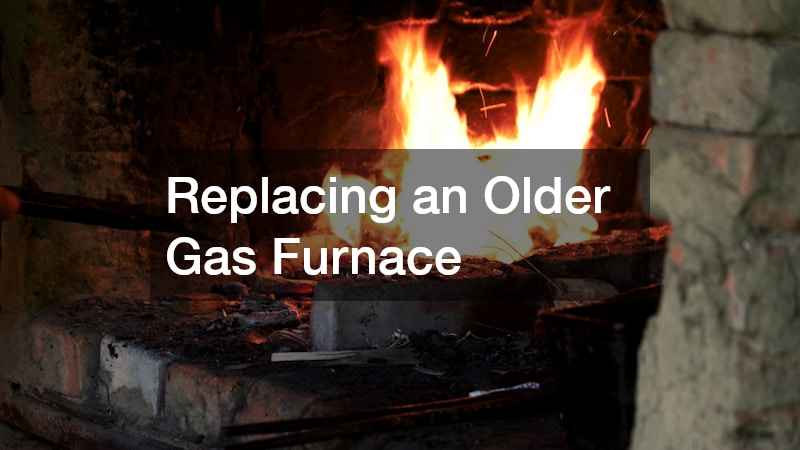Replacing an older gas furnace is a major home improvement decision that can significantly affect your household’s comfort, energy efficiency, and monthly utility expenses. While older systems may still function, they often operate inefficiently, leading to increased costs and decreased performance. Knowing when and how to replace an aging gas furnace is essential for maintaining a safe, efficient, and comfortable home environment. This article provides a comprehensive guide to help homeowners understand the key factors involved in replacing an old gas furnace, while also exploring related services like HVAC service, leak detection service, and heating system alternatives.
What are the signs that my older gas furnace needs replacement?

Frequent Repairs
If you find yourself frequently calling for furnace repair, it could be a clear indicator that your gas furnace is reaching the end of its life. Recurrent breakdowns, particularly during peak heating seasons, suggest that internal components are wearing out. Rather than continually investing in repairs, replacing the unit can offer more reliability and peace of mind.
Rising Energy Bills
An older furnace tends to consume more fuel to deliver the same level of heat, resulting in higher energy bills. This inefficiency is often due to outdated technology or worn-out components. When heating oil prices spike, operating an inefficient furnace can significantly inflate monthly expenses, especially if you rely on fuel supplied by an oil company. If your heating costs are climbing despite consistent usage habits, it’s likely time to evaluate the system for replacement.
Uneven Heating
A properly functioning furnace should distribute heat evenly throughout your home. If you’re experiencing cold spots in certain rooms or inconsistent temperatures between floors, your furnace may be struggling to circulate air effectively. These issues can stem from deteriorating ducts, which may benefit from professional duct cleaning to remove obstructions and restore airflow.
Unusual Noises
Uncommon sounds such as banging, rattling, squealing, or humming often suggest mechanical issues. These noises typically stem from loose or broken parts, failing motors, or air pressure imbalances. If such problems persist even after HVAC service calls, investing in a new system may prove more cost-effective in the long run.
Age of the Furnace
Gas furnaces typically have a lifespan of 15 to 20 years. If your furnace is approaching or has surpassed this range, it’s prudent to start planning for a replacement. Even if the unit still operates, efficiency tends to fall short of modern standards, which can diminish home comfort and increase operational costs.
How do I choose the right replacement for my older gas furnace?
Assessing Furnace Size
Proper sizing is crucial when selecting a new furnace. An undersized unit won’t adequately heat your home, while an oversized one may cycle too frequently, leading to inefficiency and premature wear. A certified HVAC service technician can conduct a detailed load calculation to ensure the unit matches your home’s heating requirements.
Evaluating Energy Efficiency
Modern furnaces boast high Annual Fuel Utilization Efficiency (AFUE) ratings. Systems with a rating of 90% or higher convert most of the fuel into usable heat, greatly improving overall heating efficiency. High-efficiency systems reduce waste and lower operating costs, which is especially beneficial when heating oil prices rise.
Considering Brand Options
Furnace quality can vary by brand. Some manufacturers specialize in integrated systems that work well with complementary equipment, such as air conditioning units and mini split heat pump services. While some homeowners prefer traditional gas systems, others may choose heat pumps to gain both heating and cooling capabilities, particularly in milder climates.
Determining Budget Constraints
Budget is a significant factor in any replacement decision. While you want a reliable unit that meets your heating needs, consider long-term savings when comparing options. Some systems may be more expensive upfront but provide better energy efficiency and fewer repairs over time. Discuss financing options with your HVAC service provider to ease upfront costs.
Understanding Advanced Features
Today’s furnaces come with variable-speed motors, smart thermostats, and zoned heating capabilities. These advanced features allow for more precise control and better energy usage. If your home has inconsistent heating or drafty areas, zoned systems or mini split heat pump services can improve comfort without overburdening your main furnace.
What are the potential costs involved in replacing an older gas furnace?

Installation Fees
Professional installation ensures safe and efficient system performance. Fees vary based on system complexity, home layout, and regional labor costs. Installers may also provide related services such as leak detection services or duct cleaning to optimize airflow and safety.
Furnace Unit Costs
The cost of a new furnace depends on size, efficiency, and brand. Basic models start at a few thousand dollars, while high-efficiency or dual-stage systems may be more. If you’re switching fuel types or integrating new heating methods, such as adding a mini split system, additional equipment will increase the total cost.
Additional Equipment Needs
Replacing your furnace may require upgrades to thermostats, ductwork, or ventilation. For homes with aging systems, complementary work by plumbers or electricians might also be necessary, especially if the existing infrastructure doesn’t meet modern standards.
Ongoing Maintenance Expenses
While new systems are less likely to break down, ongoing maintenance is vital for longevity. This includes seasonal HVAC service checks, filter replacements, and professional inspections. Regular maintenance reduces emergency ac repair calls and keeps your entire HVAC system running smoothly.
Possible Financing Options
Many HVAC companies offer flexible financing programs to help homeowners spread out the cost of new systems. Utility rebates and energy incentives can also reduce out-of-pocket expenses. Check with your local utility provider and oil company to learn about available discounts or rebate programs tied to high-efficiency furnace upgrades.
How does furnace efficiency impact energy bills?
Understanding AFUE Ratings
AFUE ratings measure how efficiently a furnace converts fuel into heat. A system with a 95% AFUE rating wastes only 5% of its fuel, making it far more efficient than older models. Understanding this rating helps homeowners make smarter choices when shopping for new heating systems.
Comparing Older vs. Newer Furnace Efficiency
Older furnaces with AFUE ratings of 60% to 70% are significantly less efficient than newer models. Upgrading can reduce monthly heating expenses, especially during colder months or when heating oil price volatility impacts fuel costs. New systems optimize performance while consuming less fuel.
Projecting Potential Savings
Depending on your current setup, upgrading to a high-efficiency furnace could reduce your heating bills by 20% or more. These savings are even more dramatic when you also invest in complementary services like duct cleaning or sealing air leaks.
Fuel Type Considerations
Natural gas is common, but some homes still use heating oil or propane. Switching fuel types may involve coordination with an oil company or local gas utility. Fuel availability, pricing trends, and environmental impact should all be considered before making a final decision.
Importance of Proper Installation
Even the most efficient furnace won’t deliver savings if it’s improperly installed. Professional installation ensures compatibility with existing systems, correct airflow, and safe gas line connections. Trusted HVAC service providers handle these details to ensure your investment performs as intended.
What is the installation process for a new furnace?

Evaluating Home Requirements
The installation process begins with a detailed assessment of your home’s size, insulation levels, ductwork condition, and heating needs. This evaluation helps HVAC service professionals determine the right furnace size and any necessary system upgrades.
Removing the Old Furnace
Once a new system is selected, technicians disconnect the old furnace, shut off gas lines, and remove outdated components. This process also includes an inspection of the surrounding area for any issues like gas leaks or damage requiring attention by plumbers or technicians.
Setting Up Ductwork
The existing duct system may need repairs or enhancements. Proper ductwork ensures consistent airflow, and thorough duct cleaning during installation removes accumulated debris that could hinder performance.
Connecting Gas Lines
Connecting gas lines safely is a critical step that requires experienced professionals. Leak detection service may be employed to verify system integrity and prevent future hazards. All connections must meet safety regulations and local building codes.
Conducting Safety Inspections
Before activating the new system, installers conduct safety and performance inspections. These include testing the thermostat, verifying ignition reliability, checking airflow, and ensuring that all safety features function properly.
Are there environmental considerations when replacing an older gas furnace?
Reducing Carbon Footprint
Modern high-efficiency furnaces consume less fuel and emit fewer greenhouse gases. Replacing an old unit with a newer model significantly reduces your home’s carbon footprint, especially when combined with energy-saving practices.
Benefits of High-Efficiency Models
High-efficiency furnaces produce less waste and require fewer resources to maintain indoor comfort. This not only helps the environment but also contributes to better indoor air quality, especially when duct cleaning is performed regularly.
Recycling Old Equipment
Many HVAC service companies offer recycling services for old systems. Recycled parts reduce landfill waste and recover valuable materials. Environmentally conscious homeowners can ensure that their replacement is both efficient and sustainable.
Compliance with Regulations
New systems must comply with current environmental and safety regulations. Professional installers ensure that your new furnace adheres to all standards, including emissions, fuel efficiency, and proper ventilation.
Exploring Renewable Alternatives
Homeowners interested in reducing fossil fuel usage may consider mini split heat pump services, solar-assisted systems, or hybrid heating solutions. These systems often pair with existing HVAC infrastructure and offer both heating and cooling benefits.
What maintenance is required for a new gas furnace?
Regular Filter Replacements
Replacing filters every one to three months keeps your furnace running efficiently. Dirty filters restrict airflow, reduce efficiency, and can lead to system failures requiring furnace repair.
Annual System Checks
Schedule annual maintenance with your HVAC service provider. These checks include inspecting burners, tightening connections, calibrating thermostats, and cleaning internal components to ensure top performance.
Pilot Light and Thermostat Inspections
The pilot light and thermostat must operate correctly for safe and efficient heating. Routine inspections catch small issues before they become major problems that require emergency service or ac repair.
Cleaning Vents and Ducts
Clean vents and ducts improve air circulation and system efficiency. Duct cleaning helps remove allergens, dust, and obstructions that hinder airflow and degrade indoor air quality.
Professional Maintenance Services
Regular maintenance from certified HVAC professionals extends your furnace’s lifespan and maintains efficiency. These services reduce the risk of breakdowns and ensure that your heating system performs well year-round.
How long can I expect a new furnace to last?
Average Lifespan of New Furnaces
A well-maintained gas furnace typically lasts 15 to 20 years. Some units may last longer with regular service, timely repairs, and proper installation.
Factors Affecting Longevity
Usage patterns, climate conditions, and maintenance habits influence how long your furnace lasts. Systems subject to frequent use or lacking maintenance may require earlier replacement.
Importance of Regular Maintenance
Routine HVAC service keeps your system running efficiently and catches problems early. Scheduling annual check-ups is one of the most effective ways to extend furnace life.
Signs of Wear and Tear
Increasing noise, inconsistent heating, or reduced efficiency are all signs that your furnace may be wearing out. Prompt attention and minor furnace repair can delay the need for full replacement.
Prolonging Furnace Life
Good maintenance habits, such as changing filters and scheduling professional inspections, are essential. Sealing ducts and addressing leaks through a leak detection service can also improve performance and longevity.
What are common mistakes to avoid when replacing an older gas furnace?
Underestimating Sizing Requirements
Incorrectly sizing your furnace can lead to poor performance and higher energy bills. Always consult an HVAC service professional for a detailed assessment of your home’s needs.
Ignoring Energy Ratings
AFUE ratings are critical for understanding efficiency. Avoid the mistake of choosing a lower-rated unit just to save on upfront costs—doing so could increase operating expenses, especially during periods of high heating oil prices.
Skipping Professional Installation
Professional installation ensures safe operation and efficiency. Unlicensed installations often violate codes, create safety risks, and void warranties.
Overlooking Warranty Options
Warranties protect your investment against defects and early failures. Make sure to understand your warranty coverage and register your new furnace if required.
Neglecting Regular Maintenance
Failing to maintain your furnace reduces its lifespan and increases the likelihood of breakdowns. Schedule HVAC service regularly and don’t delay small furnace repair needs.
How can I maximize the efficiency of my new furnace post-installation?

Ensuring Correct Thermostat Settings
Using a programmable or smart thermostat helps reduce energy waste. Set appropriate heating schedules based on your daily routine for optimal efficiency.
Sealing Ductwork for Efficiency
Leaky ducts can lose as much as 30% of heated air. Sealing ducts after installation ensures that warm air reaches your living spaces without unnecessary loss.
Utilizing Zoned Heating
Zoning allows you to control heating by area, reducing strain on your system. Mini split heat pump services are especially useful for creating separate temperature zones.
Scheduling Regular Maintenance
Consistent HVAC service keeps your system in top condition. Preventive maintenance identifies inefficiencies and corrects them before they cause major issues.
Implementing Energy-Saving Practices
Simple habits like insulating doors and windows, closing blinds at night, and scheduling regular duct cleaning all contribute to greater furnace efficiency.
Final Thoughts
Replacing an older gas furnace is more than a routine upgrade, it’s a strategic investment in your home’s comfort, efficiency, and environmental responsibility. By recognizing the signs of a failing system, understanding modern heating options, and committing to proper installation and ongoing maintenance, homeowners can enjoy improved performance and lower energy bills for years to come. Thoughtful decisions today ensure that your heating system supports comfort and sustainability well into the future.



